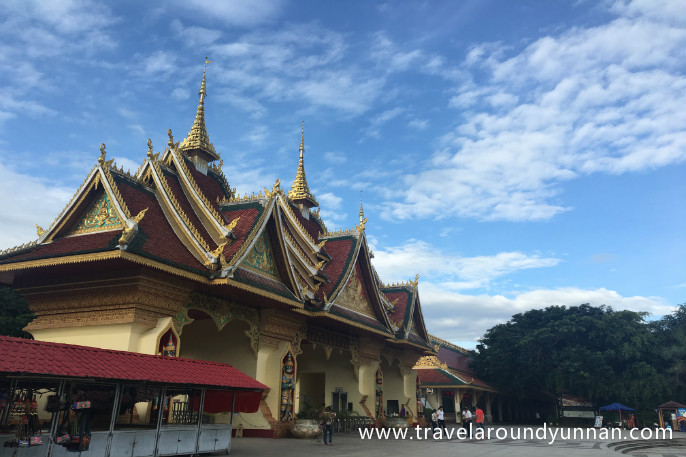
Yunnan is an important pilgrimage destination in the world with compatible religious beliefs for which one can experience Theravada, Mahayana and Tibetan Buddhism. TravelAroundYunnan listed some of the famous temples in Yunnan.
Bamboo Temple
Bamboo Temple was about 12 km from downtown of Kunming. It's one of the Zen Buddhist temples in central Yunnan Province, the temple is highlighted by the 500 clay Arhats each of which has a unique and distinctive expression, gesture and pose reflecting a very broad and realistic range of personalities and occupations and of course no two are the same. At one corner of the Majestic Hall is a stone tablet inscribed with the imperial edict of the Yuan Dynasty (1279-1368). The life-sized and well-proportioned Luohan statues was preserved well in the temple. Unlike the Buddha statues often seen in other temples, which are imposing, magnificent and awe-inspriing, Luohan staues are secularized gods. The statues in Bamboo Temple are more funny and more close to our life.
Yuantong Temple
Yuantong Temple is the earliest Buddhist temple for Goddess of Mercy (Avalokitesvara ) in China which was first build over 1200 years ago. Yuantong means understanding and enlightenment. Adopting the style of garden architecture which typical of the south of the Yangtze River region in the building of a solemn Buddhist temple is unique feature of the temple. In the Majestic Hall of temple are two giant dragons which seems as if they are about to fight. Behind the Majestic Hall is a shrine dedicated to the Bronze Buddha presented by the Thai Buddhist circle to Yunnan in 1982. Yuantong temple now is the site of the Buddhist Association of Yunnan.
Chongsheng Temple
Chongsheng Temple is in Dali old Town. Dali is the renowned “Fragrant Kingdom of Buddhism”. The temple was constructed in the Nanzhao Kingdom period (738-937) and the most famous inside it is the Three Pagodas which is the landmark of Dali. Being one of the oldest and grandest Buddhist architectures in south china three pagodas of the Chongsheng Temple is always related to ancient culture of Yunan, and they were designated as the national preserved antic spots in 1961 among the first list.
Yufeng Temple
At the southern foot of Jade Dragon Snow Mountain, 13 kilometers (nine miles) northwest of the Old Town is a small lamasery named Yufeng Temple.Constructed in 1700 during the Qing Dynasty in a mixed architectural style of Han, Bai and Tibetan, Yufeng Temple comprised as many as nine courtyards at its maximum area, but only the main hall and two courtyards exist today. Inside the temple plant several famous and precious flowers and trees (e.g. camellia, oriental cherry, wild rose, Magnolia delavayi), with evergreen pines and cypresses, crystal spring and pool dotting around the temple. From historical meaning, Yufeng Temple is a historical witness of the peaceful coexistence and syncretism of multinational cultures and religions, and still plays a very important role in acculturation of Naxi Ethnic Group.
Songzanlin Lamasery
Constructed in 1679, Songzanlin Lamasery is the largest Tibetan Buddhist temple in Yunnan Province and one of the major thirteen temples in the Tibetan-inhabited area. The magnificent temple is regarded as the Smaller Potala Palace.
Inside, you can offer a prayer to the different Buddhas within the monastery. It is customary to walk clockwise within the temple. Donate any amount and you will receive Buddhist prayer beads (worn round the wrists) as well as a light knock on the head, a form of blessing by the Tibetan monk.
Gadan Dong Zhulin Temple
As one of the famous “thirteen forest” in Kangqu, it means the temple with “two benefits”, it refers to benefit others and benefit oneself in Tibetan. The temple itself situated along the Yunnan- Tibet Highway, it is 23km away from Benzlian Town. Built in the 6th year of Emperor Kangxi in Qing Dynasty (1667), the temple has a name of “Chongchong Cuogang Gun”, meaning the temple built at the bank of fairy crane lake. In 1674, it was renamed as Gadan East Bamboo. In Qing Dynasty, it got the care and support from Changdu living Buddha Pabala and the reward of Qing government, so that the temple developed rapidly. In 1905, the monks of the Temple attended the movement of expelling foreign missionaries by Deqin people from various nationalities , suppressed seriously by the Qing government, and fined for 10000liang sliver.
.
Mengle Temple
Mengle Temple is located in Jinghong city, Xishuangbanna Prefecture.
In 2005, the temple was reconstructed at the former site of the ancient Dai imperial temple-Jingpiao Buddhist Temple. According to historical records, the Jingpiao Buddhist Temple was constructed in the Ming Dynasty (1368-1644) as one of symbolic architectures of the twelve basins of Xishuangbanna. In the temple is a giant, magnificent statue of the Buddha.

Manchunman Temple
Same with Mengle Temple, Manchunman Temple is also in Jinghong City, Xishuangbanna Prefecture. It was located in the Dai Garden of Menghan Town. The 1,400 years old temple is said to be the first Buddhist temple built after Theravada was introduced into Xishuangbanna. The former temple was once ruined in the 1960s.